It is not uncommon to find an old Japanese motorcycle with a sticking front brake caliper. In my experience this is usually an easy fix. Even on 30 year old Japanese bikes, the brake caliper can be fixed ďfor freeĒ (or about three dollars if you include the cost of brake fluid and a Scotch Brite pad ô). In most cases, no parts need to be replaced! This is amazing, but very true.
The first trick you should know is how to temporarily free the caliper. If you just bought a bike with a frozen front caliper, it is tough to push it into your truck bed, trailer, etc if the front wheel wonít move. Even a 500cc bike gets heavy fast if you have to slide it along. If you tap the caliper with something heavy, it should release. A big hammer is the best thing to use of course. Donít hit it really hard because the caliper is made of soft aluminum and could be malformed. Just a tap on the caliper and it should release. Then the wheel should turn easily. Just be sure not to squeeze the brake lever because the caliper will probably stick again. If the tapping trick doesnít work, loosen the caliper bolts until the wheel moves freely. You canít safely ride the bike like this (duh), but at least you can push the bike into your truck. OK, I know that the old school chopper guys didnít have front brakes. But Iím not going to be responsible for any fiery crashes seen on CNN. One of my bros years ago claimed he didnít need any brakes because he could just downshift. I havenít seen him for a while; and I wonder if heís still alive. In any case, letís talk about fixing the brakes. I will assume you are one of those sane individuals who wants his brakes to work.
The first step to fixing the problem is to take off the caliper. Donít remove the brake hose. You will be fixing the caliper while it is still connected to the bike.
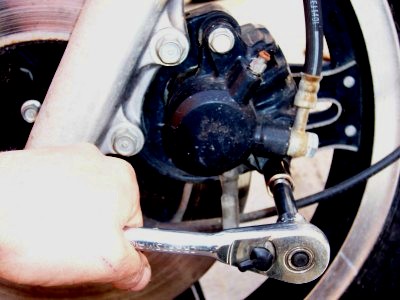
Next remove the caliper piston from the caliper. You will accomplish this by simply pumping the brake lever. With each pump the piston should move slightly.
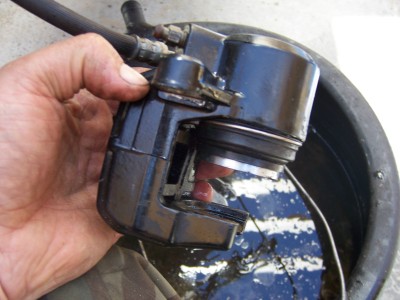
You need to pump the lever a lot, so donít get impatient and give up. As the piston starts to come out, you should see all of the gunk (which is causing the problem).
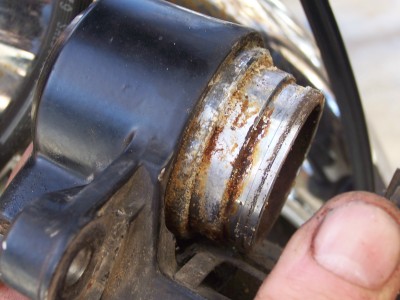
After enough pumps, the piston simply falls out of the caliper. Clean the piston with a Scotch Brite ô pad or equivalent. You should polish off the rust. When you are done, it should look shiny and clean, but minor imperfections are OK. Donít panic over a slight scratch, pit, or other small flaw. It still should work fine.
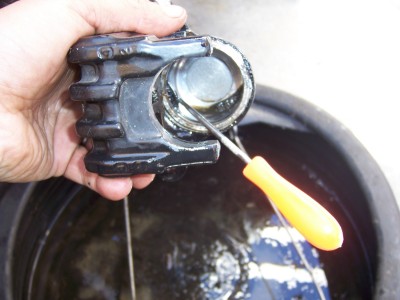
Now turn your attention to the caliper itself. Remove the O ring with a pick. Be careful not to tear or damage it. Most of the time old O rings are reusable. Clean off the crud with a rag and save it. The old O ring from the original manufacturer will probably outlast an aftermarket one. In fact, a lot of the aftermarket O rings are junk from day one and will cause you problems. If you can save the old one, you are ahead of the game. If you must replace it, try to get one from the original manufacturer or from another company you trust.
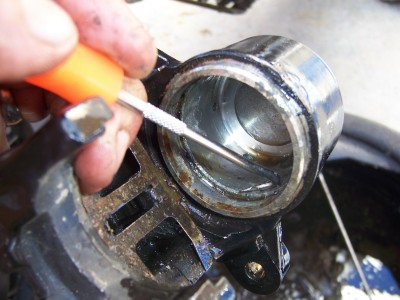
Next, clean the rust out of the channel where the O ring sits in the caliper. Take your time. The rust and crud under the O ring is basically the problem that causes the caliper to stick. Also clean out the inside of the caliper bore with a Scotch Brite ô pad.
Lubricate the O ring with new brake fluid and put it back in the caliper.
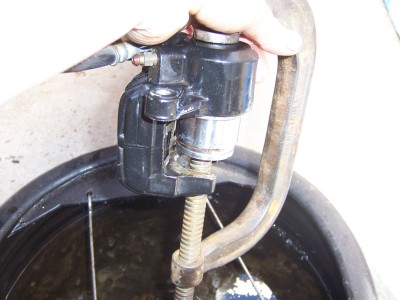
Lubricate the piston and the caliper bore with new brake fluid. Install the piston in the caliper using a C clamp. If you donít have a C clamp, go and buy one. A cheap one from Walmart ô or your local discount tool store is fine. The piston should go in without excessive force.
Install the caliper. Bleed the front brakes. And youíre done!
Test the front brake operation (in the shop before you ride it. Duh.) They should work fine.
Yay! Success. What many people call a ďbig problemĒ, you have just fixed for free.
If you had taken it to many (not all) shops, they might have quoted you $500 for labor + parts (that you didnít really need). Even if a shop is honest, their tech might not know that the parts are reusable. And a quote that high might have been more than your old Japanese bike is worth. Free sounds better to me.
Welcome to the world of the Rat Chopper.
TERMS OF USE- Use of this site is at your own risk!
The Tech Tips section of the web site is meant to be a help for motorcycle mechanics / technicians.
If you are not a mechanic, and you do repair your own motorcycle, have a professional mechanic
supervise and check your work. It is your responsibility to check the accuracy of all information
provided on this web site.
WARNING- Operating a motorcycle can be dangerous. Improper repair or modification of a motorcycle can
result in serious injury or death.
It is your responsibility to make sure your motorcycle is safely maintained.
HOME